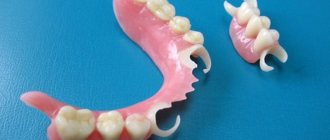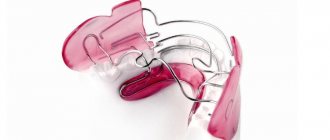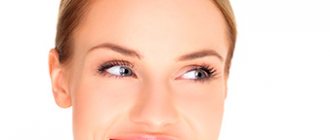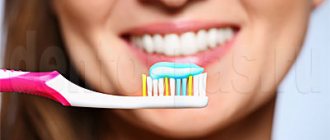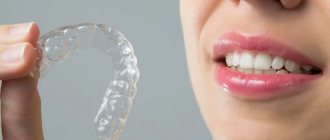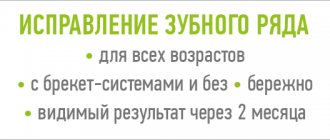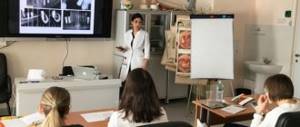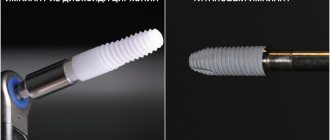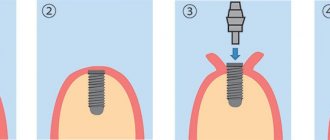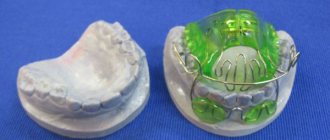1479
Crossbite is one of the most complex orthodontic pathologies. Of the total number of patients with malocclusion, only 2% have a crossbite.
The anomaly requires complex multi-stage treatment. And in some cases, the situation can only be corrected through surgery .
Causes and consequences of crossbite
There are many reasons for crossbite. They are divided into two types - congenital and acquired. The first includes the following:
- genetic predisposition or heredity;
- viral or somatic diseases suffered by a woman during pregnancy;
- bad habits and unbalanced diet.
As for the external causes of crossbite, most of them are associated with a very early age. These include:
- birth head injuries;
- injuries received in the first year of life;
- long-term use of pacifiers and nipples;
- the child's habit of sucking his thumb or foreign objects such as toys, pens, etc.;
- habit of propping one's cheek with one's fist or palm.
If such factors have influenced the formation of the bite, parents should begin treatment of the pathology as early as possible.
There are also reasons that can affect bites at any age, even as an adult. They are associated with disruption of the endocrine system, the presence of bone and joint diseases, as well as a significant decrease in immunity.
The consequences of crossbite directly depend on the quality of its treatment. If you carry out therapy on time, you can get rid of the disease completely. However, if timely assistance is not provided, the patient may face the following complications:
- Due to the inability to chew food well, its large solid parts will provoke gastrointestinal diseases.
- Due to the displacement of the jaws, defects in the placement of the tongue, lips and other parts of the face may occur, which causes aesthetic discomfort and speech disorders.
Important! It should be remembered that malocclusions that are not corrected in childhood may be difficult to correct in adults. In some cases, the desired effect will not occur. Therefore, it is better to start treatment as early as possible.
Possible complications
Crossbite is a serious anomaly that can lead to a number of complications :
- Impaired breathing function, as a result of which nasal breathing is replaced by oral breathing.
- Dental problems: loosening and loss of teeth, rapid wear of enamel, caries, periodontal inflammation.
- Malfunction of the jaw joint, which can lead to its temporary blocking, the appearance of constant headaches, and increased pressure.
- Diseases of the gastrointestinal tract, which are provoked by a lack of quality chewing of food.
Classification and stages of crossbite
Crossbite has several varieties:
- Lingual, in which the upper jaw expands and the lower jaw narrows. It can be observed on one side or both. It happens with or without displacement.
- Buccal – expansion of the lower jaw with a parallel narrowing of the upper. It may also have a displacement and be observed on one or both sides.
- Buccal-lingual is a combined type of bite that combines the characteristics of the previous two.
Also, the types of crossbites are divided based on the stage at which the pathology is at a particular moment. In this case, the following main stages are distinguished:
- milk stage, when malocclusion is observed in young children before the growth of permanent teeth begins;
- replaceable - occurs at the stage of replacement of the milk dentition with permanent ones;
- constant, which can be said to exist in the presence of a defect after the appearance of permanent teeth.
Depending on the type of defect and the stage of its development, the doctor can select the most effective treatment.
Symptoms
The main symptom of the disease is the incorrect location of the jaw bones in the oral cavity. In addition, 70-80% of patients are diagnosed with symptoms:
- Increased bleeding of gums. Due to the disorder, the teeth in the mouth are in the wrong position and come into contact with each other. This leads to gradual loosening of the teeth and microtrauma of the gums, which are accompanied by bleeding. In a normal state, bleeding with PP usually does not occur - it appears during eating, when brushing teeth, during prolonged exposure to cold air, and so on.
- Increased risk of developing dental diseases. Due to the appearance of gaps between the teeth, pathogenic bacteria and viruses are more likely to enter the mouth. These harmful microorganisms can cause various diseases of the oral cavity - caries, periodontal disease and others. Also, the presence of a gap between the teeth stimulates the formation of tartar, which also negatively affects the health and strength of the teeth.
- Deterioration of immunity. To neutralize pathogenic bacteria in the oral cavity, the body spends some of its immune cells. In a healthy state, viruses and bacteria in the oral cavity do not create a serious burden on the immune system. However, in the case of a viral or bacterial infection, there may not be enough immune cells to deal with several diseases at once, which will lead to a general deterioration of immunity.
- Mild pain syndrome. In case of advanced crossbite, an unpleasant aching pain in the mouth area may occur. Pain usually occurs when brushing your teeth, as well as when the body is overheated or hypothermic. For many patients, pain appears and then disappears again. This is due to the neurophysiological features of the mechanism of the onset/attenuation of pain in humans.
Diagnostics
Additional symptoms usually occur in combination rather than individually. For example, frequent bleeding in 65% of cases occurs along with deterioration of immunity. And caries is more often diagnosed in people who often suffer from bacterial and viral infections (the reason is a general deterioration of immunity). The pain syndrome usually occurs on its own (that is, such people usually do not have problems with the immune system, their gums do not bleed, and so on). Pain often occurs (in 75% of cases) as the crossbite progresses.
Several medical technologies are used for diagnosis. In the case of severe or moderate forms of the disease, an external examination is sufficient for diagnosis. To confirm the diagnosis, an impression of the teeth is made using dental plaster. To clarify the characteristics of the disease, an x-ray examination can be performed, which will show the exact location of the teeth in the oral cavity. In severe cases of the disease, a three-dimensional model of the patient’s oral cavity is also made - this can then be compared with a new model of the patient’s oral cavity after treatment.
Crossbite in a child
Crossbite in a child can appear both at a very early age and at a later date. Its rudiments can begin to form in the prenatal period or after birth under the influence of external factors. The difference from adults is that children's crossbite is more treatable, and as a result, a person can completely get rid of such a disease.
With displacement of the lower jaw
Regardless of the type of crossbite, if it is present, movement of the lower jaw may occur. It can be either pronounced or almost invisible. However, we must not forget that over the years such a defect may worsen. Therefore, its treatment should be started as early as possible.
Buccal
Buccal crossbite occurs quite often in children, compared to other types of this pathology. At the same time, the lower dentition expands significantly. The lower teeth themselves may also become wider, overlapping the upper teeth.
Unilateral
These crossbites are more common than bilateral crossbites. This pathology is characterized by the presence of expansion or narrowing on only one side of the jaw. Often, such defects are more amenable to correction, as they require less intervention. Their consequences are also not as dangerous as in the case of a bilateral defect.
Crossbite treatment
Crossbite treatment should begin immediately when such a disorder is detected. If its first signs were seen at an early age, then therapy will require less time and may be limited to the use of special bandages, mouth guards or plates. It is also very important at the initial stage of bite treatment to determine the root cause of the pathology. If it is associated with the work of any other internal systems, for example, endocrine, then it must first be fully treated.
Trainers
Trainers are the most common designs for the treatment of such an ailment as crossbite in children. They are special mouthguards made of silicone according to an individual impression. They should be worn night and day, removing for eating, socializing or playing. Such mouthguards apply pressure to the dentition, thereby moving the teeth into the desired position.
Aligners and aligners
Mouthguards and aligners have a similar effect to trainers, but differ in their shape. Such designs are intended for constant wear in case of malocclusion. They are placed separately on each row of teeth so that the jaw can open freely. Typically, these devices are made from transparent materials to make them as invisible as possible to others.
Bracket systems
Braces are considered one of the most effective designs used for the treatment of malocclusions. Such devices consist of separate braces that are attached to the teeth and a special arch. It is she who, with her traction force, moves the teeth to their anatomical location.
Osteotomy
In some cases, an osteotomy may be required to remove a crossbite. This is a surgical procedure during which the doctor cuts soft tissue and bone. After that, he installs them in the right place and fixes them.
Diagnostics
To accurately determine the presence of this disease, it is necessary to undergo a series of examinations, the results of which will shed light on the complexity of crossbite and the causes of its occurrence. An orthodontic diagnosis is preceded by a complete clinical, functional and instrumental examination.
During the initial consultation, the orthodontist examines the face and oral cavity, palpates and auscultates the temporomandibular joint, performs the necessary functional tests, and compares objective data with complaints and anamnestic information.
To study the problem more deeply, it is necessary to conduct a teleroentgenogram and an orthopantomogram of the head. When the lower row of teeth is displaced, it is necessary to take an x-ray of the temporomandibular joint.
During the examination, the type and form of crossbite, its etiology, and associated disorders are determined, which affects the volume and sequence of implementation of treatment measures.
A detailed determination (multi-faceted diagnosis) of the presence of a given problem and the degree of its complexity directly affects the success of subsequent treatment.
Prevention and prognosis
Prevention of such a defect as crossbite should begin during a woman’s pregnancy. She should lead a healthy lifestyle, watch her diet, and exercise moderately. It is also important to avoid all kinds of infections and viruses. To do this, it is better to avoid visiting crowded places and communicating with carriers.
After the baby is born, he needs constant monitoring. At this stage, it is important to choose the right pacifier and pacifier, and, if possible, do without these devices. To do this, it is better to consult a pediatric dentist or pediatrician. It is also necessary to ensure that the child does not get carried away with thumb sucking or toys, and does not receive any injuries to the facial part of the head.
The prognosis of such a malocclusion depends on how well the treatment was carried out. Often the defect can be completely removed.
Important! Do not forget that at the initial stage only a specialist can identify dental deformation. Therefore, it is necessary to visit the dentist regularly from the moment the first baby teeth grow.
Treatment prices
The cost of treating crossbite depends on the degree of damage, the individual characteristics of the patient, as well as the professionalism of the doctor and the level of the clinic in which the therapy will take place. Typically, prices for a full range of services start from 8 thousand rubles. In some cases, if it is necessary to wear special structures or perform an operation, the total cost can rise to 30-60 thousand rubles.
The iOrtho clinic network provides high-quality services for correcting malocclusion with Invisalign aligners, sign up for a consultation now!
Popular questions
Let's look at some popular questions from readers about crossbite.
Are traditional treatment methods effective against PP?
No, there are no effective folk methods to correct this defect. Dental lotions, tinctures, and ointments do not help against this disorder. This fact is confirmed by scientific research and the experience of many dentists. Effective therapeutic methods include the use of braces, crowns, aligners, or surgical intervention using osteotomy. However, folk remedies can be used to relieve pain (however, with PP it appears quite rarely).
Can children have an osteotomy to correct a dental defect?
Technically, such an intervention is quite acceptable, but in practice it is rarely used. The child’s jaw bones are in the stage of active growth, so PP can be corrected using safer and painless methods (braces, crowns, aligners). The use of osteotomy can be justified only in cases of severe crossbite, when the possible positive effects of therapy outweigh the negative ones (for example, in case of severe curvature of the jaw bone due to an accident).
Does your mouth hurt after an osteotomy? Is it possible to have surgery without pain?
Pain after osteotomy is diagnosed in 80% of patients. The pain usually disappears completely 3-10 days after surgery, depending on the individual characteristics of the body and the severity of the operation. However, this does not mean that you have to suffer all this time. Analgesics from the NSAID group (non-steroidal anti-inflammatory drugs) can be used to relieve pain. If taken for a short period of time, they are completely safe and do not cause harm to the body. The selection of the optimal medicine should be done by a dentist.
What other types of malocclusion are there? How are they different from PP?
In addition to crossbite, there are also open, deep, distal and mesial malocclusions. They differ from conventional PP mainly only in the location of the jaw bones and teeth relative to each other. The causes of the disorder, diagnosis, pathogenesis, and additional symptoms will be similar. The treatment methods are also the same: to eliminate a dental defect, braces, corrective crowns, and aligners are used; in severe forms of the disease, osteotomy is used. Traditional methods are also considered ineffective.
Sources used:
- Persin L. S. Orthodontics. Treatment of dental anomalies. - M.: Engineer, 1998.
- V. N. Trezubov, A. S. Shcherbakov, R. A. Fadeev. Orthodontics. - Nizhny Novgorod: Medical book, 2001.
- American Journal of Orthodontics & Dentofacial Orthopedics.
